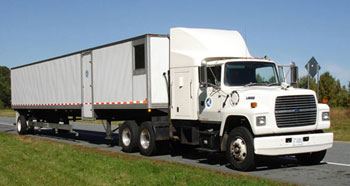U.S. Department of Transportation
Federal Highway Administration
1200 New Jersey Avenue, SE
Washington, DC 20590
202-366-4000
Focus
| Accelerating Infrastructure Innovations |
Publication Number: FHWA-HRT-08-013
Date: May 2008
Achieve high-speed structural evaluations of highway pavements using the rolling wheel deflectometer (RWD). Traditionally, engineers have used visual distress surveys to make roadway management decisions, such as which roads to schedule for improvement and the types of improvements to make. While such visual distress surveys can provide valuable information about a road's condition, including types of cracking and potential causes for the cracking, they lack a direct measure of the pavement's structural condition. The RWD is designed to collect continuous deflection profiles at normal highway speeds, without the need for lane closures, providing an innovative and improved method of evaluating pavements for pavement management purposes.
Developed for the Federal Highway Administration (FHWA) by Applied Research Associates (ARA), Inc., the RWD uses four triangulation lasers mounted on a rigid beam beneath a tractor-trailer to calculate the deflection produced by the trailer's dual-tire, 80,068 N (18-kip) single axle. This nondestructive test does not damage the pavement's structural integrity. Data is collected in real-time by the RWD's data acquisition equipment, which is located in the truck's cab. The RWD can operate at speeds ranging from 16 km/hr (10 mi/hr) to 104 km/hr (65 mi/hr), allowing it to blend in with the surrounding traffic stream. Typically, 161 km (100 mi) to 321 km (200 mi) per day can be tested. "Entire highway networks can be tested in a matter of days," says Thomas Van of FHWA's Office of Asset Management. Data can be provided to highway agencies in formats that are readily usable in pavement management systems (PMS), including formats that can link to geographic information systems.
| "Field testing has demonstrated the RDW's ability to efficiently and accurately measure pavement deflection due to an actual moving wheel load, which is something beyond the capabilities of previous types of deflection testing devices" |
 |
| The RDW collects continuous deflection profiles at normal highway speeds, without the need for lane closures. |
The RWD can be used in conjunction with existing deflection technology such as the falling weight deflectometer (FWD). The RWD is a good tool for identifying problem pavement sections that a highway agency could then revisit with the FWD for more detailed analysis.
Full-scale demonstrations of the RWD have been held in several States, including Texas, Indiana, Minnesota, and Iowa. "Field testing has demonstrated the RWD's ability to efficiently and accurately measure pavement deflection due to an actual moving wheel load, which is something beyond the capabilities of previous types of deflection testing devices," says Van. Data collected on SR 1 in Indiana, for example, clearly showed the change in deflection, indicating pavement structural capacity. As the pavement became thinner and weaker, the pavement deflections increased and became more variable. Pavements with good structural capacity and uniformity produce low, uniform deflections.
The RWD was recently used in the implementation of a PMS in Champaign County, Illinois. As with most local governments, Champaign County must consider numerous competing factors when allocating limited highway improvement and maintenance funds. To improve budgeting, planning, and incorporation of pavement preservation techniques, the county implemented a system that uses the RWD. The PMS implementation has included the following activities to provide the data, models, and economic analysis capabilities needed for pavement management:
Using the collected field data and the treatment matrix, Champaign County was able to analyze different funding scenarios and identify a list of candidate highway projects for the next 5 years. The county plans to repeat the data collection, including using visual surveys and RWD testing, every 2 years to maintain an up-to-date PMS database and management plan.
"The RWD provides never-before-available deflection data for network-level highway applications," says Van. "The end result to highway agencies is better allocation of limited highway funds by identifying pavement sections that are in need of structural improvement and selecting the most appropriate rehabilitation strategy, such as a surface treatment, asphalt overlay, or reconstruction."
For more information on the RWD, contact Thomas Van at FHWA, 202-366-1341 (email: thomas.van@fhwa.dot.gov).
| To learn more about other asset management technologies, visit www.fhwa.dot.gov/infrastructure/asstmgmt. |